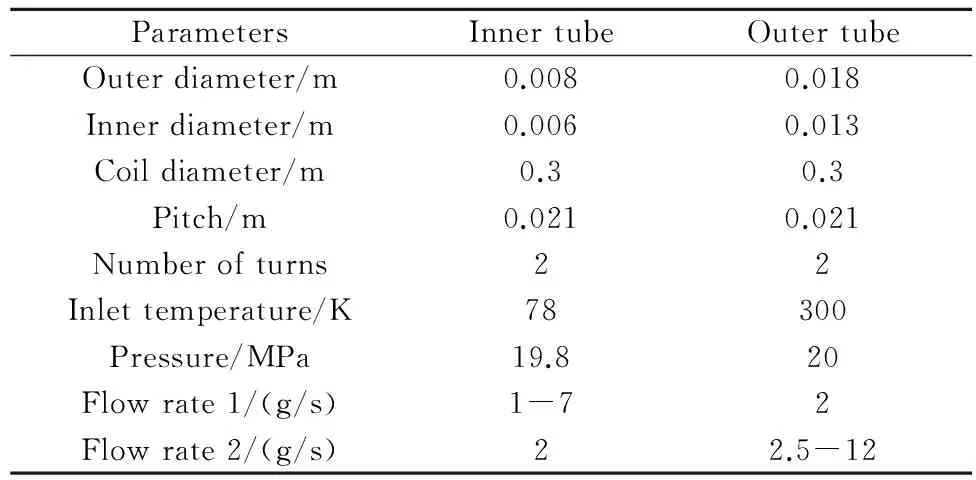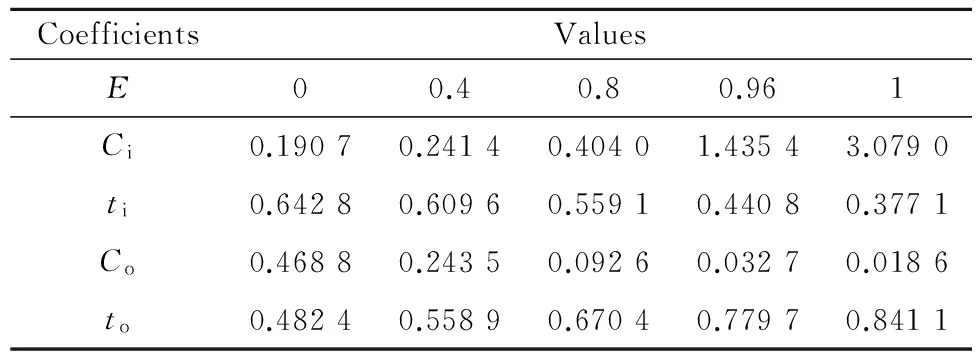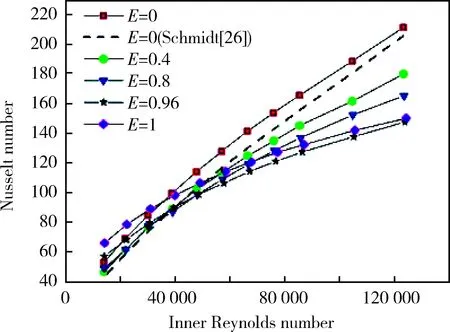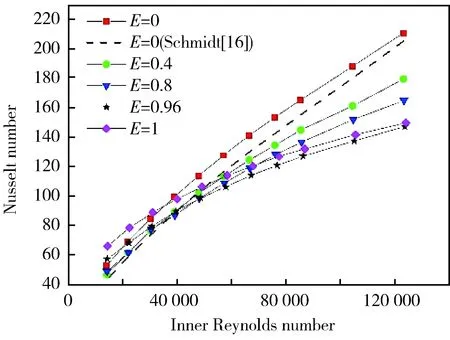Numerical studies of an eccentric tube-in-tube helically coiled heat exchanger for 20MPa helium purification system
2016-06-05ZhangJianqinLiShaopeng
Zhang Jianqin Li Shaopeng
(Institute of High Energy Physics,Chinese Academy of Science,Beijing 100049,China)
Numerical studies of an eccentric tube-in-tube helically coiled heat exchanger for 20MPa helium purification system
Zhang Jianqin Li Shaopeng
(Institute of High Energy Physics,Chinese Academy of Science,Beijing 100049,China)
The tube-in-tube helically coiled(TTHC)heat exchangers with different eccentricity ratios were numerically studied for turbulent flow. The working fluid was helium at the pressure of 20 MPa. The inner and annulus Nusselt numbers were compared between the concentric and eccentric TTHC heat exchangers. The results show that with the eccentricity increasing,the annulus Nusselt number increases substantially. According to the numerical data,new empirical correlations of Nusselt number as a function of Reynolds number and eccentricity for the inner tube and the annulus were presented. The TTHC heat exchanger of the purifier was designed under the given conditions.
tube-in-tube heat exchanger;eccentricity;helical;numerical;heat transfer
1 Introduction
Helium purification system is an important sub-system which meets the high helium purity standard of the cryogenic system in the accelerator driven sub-critical system of the Institute of High Energy Physics,Chinese Academy of Science(IHEP-ADS). The purifier includes dewar,high pressure heat exchanger,condenser,liquid air separator and adsorption cylinders. The high pressure heat exchanger is used to transfer the heat of helium between the temperature of 300 K and 78K. Because of the pressure of 20 MPa and the compact structure,tube-in-tube helically coiled(TTHC)heat exchanger is a good choice.
Helically coiled heat exchangers are superior to straight tubes,for which have compact structures and higher heat transfer coefficients. It is known that centrifugal forces caused by the pipe curvature will result in a secondary flow,which enhances heat transfer rates. A number of studies focused on the fluid flow and heat transfer characteristics in helical pipes[1-3]. Mori and Nakayama[4]theoretically and experimentally studied the flow and heat transfer in a curved tube both in laminar and turbulent regions,and provided empirical correlations. Furthermore,Rennie and Raghavan[5]conducted experimental study of a TTHC heat exchanger with different curvature ratios. Numerical methods were used to study the helical tubes with computational fluid dynamics(CFD)simulation[6]. Rennie and Raghavan[7]and Later Kumar[8]numerically studied the laminar and the turbulent flow and heat transfer of a TTHC heat exchanger. The literature above-mentioned mainly focused on the concentric TTHC heat exchangers,while in many practical situations,they are eccentric,coiled without sharing the same vertical or horizontal center line. Louw and Meyer[9]experimentally compared the annular contact TTHC heat exchanger with a concentric one. Besides, natural convection and turbulent forced convection flow in vertical eccentric annulus were investigated experimentally[10-13]. However,the eccentric TTHC heat exchanger hasn’t been studied systematically.

2 Materials and methods
A sectional view of a vertical eccentric TTHC heat exchanger is show in Figure 1a. The eccentricity of the inner tube ranges from the concentric case(E=0)to the annular contact case(E=1),which is 0,0.4,0.8,0.96 and 1 respectively. Considering the manufacturing condition,the case ofE=1 is welded with copper,which is shown in Figure 1b. Except for the different eccentricity ratios,the geometries of the eccentric TTHC heat exchangers are same. The outside diameter of the inner tube is 8mm with a wall thickness of 1 mm,while the outside diameter of the outer tube is 18mm with a wall thickness of 2.5 mm.

Fig.1 Sectional views of a TTHC heat exchanger
The transport and thermal properties of helium were dependent on the temperature. Fluent was used in the simulation. The geometrical and flow parameters for the inner and outer tubes are given in table 1.The working fluid in the inner tube and the annulus was helium,which were counter flow and heat was transferred through the copper wall. The total number of simulations performed for each type of TTHC heat exchanger was 21(11 inner tube flow rates and 10 annulus flow rates).

Table 1 Geometrical and flow parameters for inner and outer tubes
3 Results and discussion
3.1 Temperature profiles
The temperature profiles at the exit of the inner tube and the annulus forE=0 andE=0.96 of TTHC heat exchangers are given in Figure 2. The mass flow rate in the inner tube is 2 g/s,and the mass flow rate in the annulus is 10 g/s. In the Figure 2a,the outlet temperature profiles of the inner tube for different eccentricities are similar. The right side is the inner side of the coil,and has a higher temperature compared to the outer side. The average outlet temperature for the inner tube of the concentric heat exchanger is higher than that of the eccentric one. In the Figure 2b,the right side is the inner side of the coil. With the center offset increasing,the high temperature region moves from the outer side to the inner side. Moreover,the secondary flow enhanced the heat transfer in the annulus region withEincreasing.

Fig.2 Temperature profiles in inner tube/annulus for different eccentricities
3.2 Inner tube and annulus heat transfer coefficient
Heat transfer coefficients for the inner sidehiand the annulus tube sideho,were calculated with traditional Wilson plots[3,5]. Wilson plots allow the heat transfer coefficients to be calculated based on the overall heat transfer coefficient,without the requirement of wall temperature. The outer Reynolds number of the annulus was calculated by equivalent diameter. New empirical models were developed with Sieder-Tate type[14-15]equation,which was used to fit the inner and annulus Nusselt number with a coiled effect term δ0.1[4]and was the function of eccentricity. The differences between the empirical data and numerical data are less than 2%. The equations are:
(1)
(2)
Where the values of the coefficientsCi,Coandti,toare given in Table 2,for 14 000 Table 2 Values of coefficients for inner and annulus Nusselt number equation in concentric and eccentric TTHC heat exchangers The empirical constants(Ci,ti,Co,to)are related toE,and the relations are as follows: Ci=2.807E21.219+0.268 (3) ti=-0.399E2+0.173E+0.634 (4) Co=0.45E+0.441 (5) to=-0.325E2.436+0.498 (6) Figure 3 illustrates that the inner Nusselt number decreases by approximately 11.8%,14.4%,17.7% and 15.6% forE=0.4,E=0.8,E=0.96 andE=1 compared withE=0. The reason is probably that the eccentricity causes the temperature non-uniformity of the wall,and heat transfer turns worse in the lowering wall temperature region compared with the concentric one. Figure 3 also shows that the experimental data of Schmidt[16]has a good agreement with the concentric TTHC heat exchanger. Fig.3 Nusselt number vs. inner Reynolds number, average annulus Reynolds number is 7000 Figure 4 shows the Nusselt number increases with the annulus Reynolds number increasing. It can be seen from the figure that the annulus Nusselt number increases with E increasing,especially at the large Reynolds number. The Nusselt numbers in the cases ofE=0.4,E=0.8,E=0.96,andE=1 are approximately 10.8%,27.8%,34.7% and 41.2% separately higher than those in the case ofE=0. With the eccentricity ratio increasing,the flow non-uniformity is enhanced with secondary flow and the heat transfer is improved the in the annulus. Fig.4 Nusselt number vs. annulus Reynolds number, average inner Reynolds number is 28000 The relationship between the overall heat transfer coefficient and the inner/annulus heat transfer coefficient was as follows: (7) Compared with the inner and annulus heat transfer coefficients,the conduction resistance termRcis negligible. It is obvious in the Figure 3 and Figure 4 that the Nusselt number in the annulus is less than the inner tube at the same mass flow rate. So an increase of eccentricity is good for the increase of the overall heat transfer coefficient. 3.3 Friction factors The inner and annulus friction factors were as follows: (8) Where ΔPis the pressure drop of the inner tube and the annulus,Lis the length of the heat exchanger,Deis the equivalent diameter of the inner tube and the annulus andu0,rare the average velocity and the density of the inner tube and the annulus,respectively. Figure 5 shows the numerical data in the inner tube and the annulus for the concentric and eccentric TTHC heat exchangers and the experimental data of Schmidt[16]. Figure 5a presents that the inner friction factors of the concentric and eccentric TTHC heat exchangers are almost same at the same Reynolds number,and have a good agreement with Schmidt’s experimental data. Figure 5b presents that the annulus friction factor has a decrease of 13% and 25% forE=0.96 andE=1 separately compared with the value ofE<0.96. Fig.5 Friction factor versus inner Reynolds number and annulus Reynolds number 3.4 Design of the heat exchanger According to the analysis in 3.2,the case ofE=1 TTHC heat exchanger is preferred to design the heat exchanger in the purifier,especially in the high Reynolds number region. The design parameter of the heat exchanger is shown in Table 3. The diameter of the inner tube is 8 mm with a thickness of 1 mm,and the diameter of the outer tube is 16 mm with a thickness of 2.5 mm. The coil diameter is 300 mm. In order to decrease the flow resistance,the heat exchanger is divided into 5 branches. The inner and annulus heat transfer coefficients are calculated with Equations(1)and(2). The length of the tube is 16.3 m. The pressure drop of the inner tube and the annulus are 1 306 Pa and 1 885 Pa separately. Table 3 Parameters of helically coiled tube-in-tube heat exchanger Numerical studies of different eccentricity ratios of TTHC heat exchangers were performed with helium in the inner tube and the annulus. With the eccentricity increasing,the inner Nusselt number decreases slowly,while the annulus Nusselt number increases rapidly. In the case ofE=1,the inner Nusselt number decreases by approximately 15.6% and the annulus Nusselt number increases by approximately 41.2% compared with the case ofE=0. Eccentricity is good for the heat transfer of the annulus in an eccentric TTHC heat exchanger,especially in the large Reynolds number region. New empirical correlations of the Nusselt number versus the Reynolds number and eccentricity in the inner tube and the annulus were presented. The friction factors of the inner tube and annulus were studied for the concentric and eccentric TTHC heat exchangers. The heat exchanger of the purification system was designed with the case ofE=1 TTHC heat exchanger. In order to examine the reliability of CFD results,an experiment for an eccentric TTHC heat exchanger should be conducted in the future. Reference 1 R A Seban,E F McLaughlin. Heat transfer in tube coils with laminar and turbulent flow[J]. International Journal of Heat and Mass Transfer,1963(6):387-395. 2 G F C Rogers,Y R Mayhew. Heat transfer and pressure loss in helically coiled tubes with turbulent flow[J]. International Journal of Heat and Mass Transfer,1964(7):1207-1216. 3 Patankar S V,Pratap V S,Spalding D B. Prediction of laminar flow and heat transfer in helically coiled pipes[J]. J Fluid Mech,1974,62:53-551. 4 Y Mori,W Nakayama. Study on forced convective heat transfer in curved tubes(3rd report,theoretical analysis under the conditions of uniform wall temperature and practical formulae)[J]. International Journal of Heat and Mass Transfer,1967,10:681-695. 5 T J Rennie,G S V Raghavan. Experimental studies of a double pipe helical heat exchanger[J]. Experimental Thermal and Fluid Science,2005:919-924. 6 M M Asiam Bhutta,N Hayat,M H Bashir,et.al,CFD applications in various heat exchangers design:A review[J]. Applied Thermal Engineering,2012,32:1-12. 7 T J Rennie,G S V Raghavan. Numerical studies of a double pipe helical heat exchanger[J]. Applied Thermal Engineering,2006,26:1266-1273. 8 V Kumar. Numerical studies of a tube-in-tube helically coiled heat exchanger[J]. Chemical Engineering and Processing,2008,47:2287-2295. 9 Willem I Louw,Josua P Meyer. Heat transfer during annular tube contact in a helically coiled tube-in-tube heat exchanger[J]. Heat Transfer Engineering,2005,26(6):16-21. 10 Hosseini R,Heyrani-Nobari M R,Hatam M. An experimental study of heat transfer in an open-ended vertical eccentric annulus with insulated and constant heat flux boundaries[J]. Applied thermal engineering,2005,25(8):1247-1257. 11 Hosseini R,Rezania A,Alipour M,et al. Natural convection heat transfer from a long heated vertical cylinder to an adjacent air gap of concentric and eccentric conditions[J]. Heat and Mass Transfer,2012,48(1):55-60. 12 Hosseini R,Ramezani M,Mazaheri M R. Experimental study of turbulent forced convection in vertical eccentric annulus[J]. Energy Conversion and Management,2009,50(9):2266-2274. 13 Shiniyan B,Hosseini R,Naderan H. The effect of geometric parameters on mixed convection in an inclined eccentric annulus[J]. International Journal of Thermal Sciences,2013,68:136-147. 14 J W Rose. Heat-transfer coefficients,Wilson plots and accuracy of thermal measurements[J]. Experimental Thermal and Fluid Science,2004,28:77-86. 15 Incropera F P,DeWit D P. Introduction to heat transfer(3rded.)[M]. New York:John Wiley&Sons,1996:544. 16 Schmidt E F. Warmeubergang and druckverlust in rohrschlangen[J]. Chemie-Ing-Techn,1967,39:781-789. 2016-09-28; 2016-11-01 张建琴,女,29岁,博士、工程师。Zhang Jianqin,female,29 years old,doctor and engineer of Institute of High Energy Physics,Chinese Academy of Science. TB611 A 1000-6516(2016)06-0062-06 螺旋式偏心套管换热器的数值模拟 张建琴 李少鹏 (中国科学院高能物理研究所 北京 l00049) 采用数值模拟的方法研究了不同偏心度螺旋套管换热器在紊流区域的换热和流动特性。为了使计算结果更贴近实际情况,模拟计算中采用的是氦气在压力为20 MPa条件下的温度依赖的变物性参数。通过数值计算结果,比较了同心和偏心螺旋套管换热器内管和外管的换热系数,其中外管的换热系数随着偏心度的增加而大幅增加。根据计算结果提出了套管换热器内管和外管换热系数随偏心度和雷诺数的变化关系式。最后在给定的条件下设计了纯化器中的偏心套管换热器。 螺旋式套管换热器 偏心 换热 数值计算




4 Conclusions
